The city of Ordos in Inner Mongolia autonomous region, located at 37 degrees north latitude, sits within an arid and semi-arid transition zone of desertified and semi-desertified grasslands. At the time of the founding of the People's Republic of China, 96 percent of Ordos' land area was covered with deserts, sandy lands, arid hard beams, and hilly and gully area. It was a city where drought occured nearly nine years out of ten. Change was inevitable and necessary.
Over the past 75 years since the country's founding, Ordos has been committed to ecological construction, fostering harmony between humans and nature. Today, the city is not only home to deserts, but also scenic rivers, vast grasslands and magnificent canyons. Green development is blooming with unprecedented brilliance across the city.
Behind these achievements are generations of efforts to create this ecological miracle.
From unforgiving desert to oasis
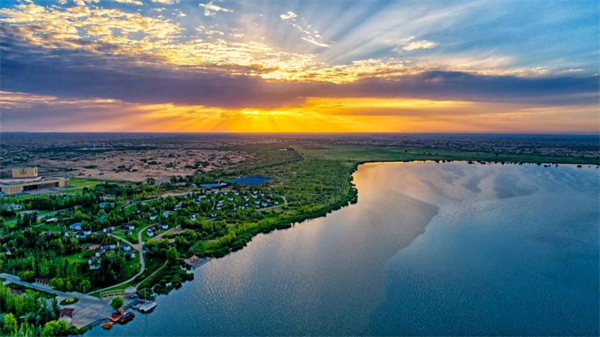
Ordos is now home to lucid waters and lush greenery. [Photo provided to investordos.goinnermongolia.com.cn]
In 1978, China's largest ecological project, the "Three-North" Shelterbelt Forest Program, was launched, and the Kubuqi Desert became the main battlefield.
Stretching across Ordos' Hanggin Banner, the Kubuqi Desert covers 53 percent of the banner's total land area. Its hinterland was once barren and uninhabited, with severe wind erosion and sand burial, earning it the reputation of an untamed "Sea of Death".
From 1997 to 1999, to combat the harsh environment of "sands advancing, people retreating" and to break the millennium cycle of poverty caused by sand, 130,000 Hanggin Banner people erected more than 20 million hectares of sand barriers along roadsides after seven major battles, paving a sand-crossing highway running through the north and south of the desert.
Having fought against sand for years, the people of Hanggin Banner know that sand control goes far beyond simply planting trees and sand fixation. It is a complex project that requires technology, innovation and perseverance.
In the past 75 years, they have explored a new path of ecological construction and desertification prevention tailored to Hanggin Banner. The banner has developed an anti-desertification model of "engineering sand fixation + afforestation and grass planting + flying sowing grass + fence enclosure + follow-up consolidation and improvement + achievement protection", and created a number of advanced methods in sand control, such as water-impact planting and spiral-drill planting.
As of the beginning of 2024, Hanggin Banner had completed a total of 1.39 million mu (924,306.67 hectares) of key ecological projects for forests and grasslands and restored 4.84 million mu of the Kubuqi Desert, achieving a historic shift from "sands advancing, people retreating" to "greenery advancing, sands retreating".
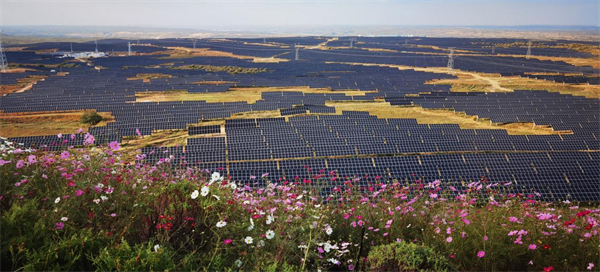
An aerial view of photovoltaic panels in the Kubuqi Desert. [Photo provided to investordos.goinnermongolia.com.cn]
In order to allow farmers and herdsmen to benefit from ecological construction and boost incomes, Hanggin Banner has been actively promoting the construction of a comprehensive photovoltaic desertification control project that integrates clean energy, efficient digital agriculture, ecological restoration, and eco-livestock farming.
At the same time, capitalizing on its three primary natural resources – desert, grassland and the Yellow River – the banner has built three national 4A-level tourist attractions, one national 3A-level attraction and two national 2A-level attractions.
Since 2012, nearly 30,000 people in the banner have been lifted out of poverty, with the per capita annual income of farmers and herdsmen doubling repeatedly. In July 2018, the banner shed its designation as an impoverished county. The restoration of the Kubuqi Desert exemplifies the development concept of "lucid waters and lush mountains are invaluable assets".
Over the past 75 years, the once barren land has been slowly transformed into an oasis, with generation after generation of Ordos people unremittingly carrying out ecological construction efforts based on sand control and afforestation. It is their extraordinary perseverance and the sweat of their brows that has created a green sea on sand dunes and turned the desert into something they can benefit from.
The picture of "greenery advancing, sands retreating" vividly showcases the game between man and nature, as well as the spiritual confrontation between life and desolation, hope and despair.
From yellow to green and blue
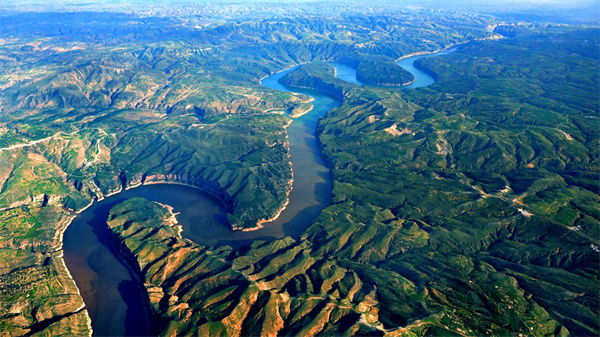
The Yellow River flows through Ordos. [Photo provided to investordos.goinnermongolia.com.cn]
The Yellow River, the mother river of the Chinese nation, after flowing through the territory of Ordos in North China's Inner Mongolia autonomous region, is pulled out like a bow winding through several grand bends.
In Ordos, the Yellow River nestles in the desert and shakes hands with the grassland, creating magnificent scenery.
"When the Yellow River does not flood, the world is at peace". This old Chinese saying was deeply felt by Ordos, where the ecosystem had once long been fragile.
Located in the Loess Plateau, Ordos once faced significant erosion during flood seasons, with the rain washing a large amount of sediment into the Yellow River.
This led to siltation, and riverbed elevation over millennia of interplay between river and plateau, and created 10 primary tributaries of the Yellow River, known as the "Shida Kongdui" region.
Flowing from south to north through Ordos' Kubuqi Desert and alluvial plains, the 10 tributaries deposit about 27 million metric tons of sediment into the Yellow River annually, severely impacting the river's ecosystem and regional development stability.
Rectification and governance are urgent priorities. In order to regulate the water-sediment relationship and ensure the safety of the Yellow River, Ordos has carried out comprehensive management of the "Shida Kongdui" region – developing tailored strategies for each tributary and short and medium-term governance plans.
This approach combines natural restoration with artificial management, engineering measures with biological methods and governance protection with development and utilization to achieve a dual decrease in both the area and intensity of soil erosion.
Today, the comprehensive management of the "Shida Kongdui" region has become a national benchmark for soil erosion control, with the erosion area decreasing from 71,159 square kilometers in 1995 to 33,818 sq km in 2021, a reduction of 52.5 percent.
In 2023, as part of the "important ecological security barrier in northern China", Ordos has promoted the integrated protection and systematic management of mountains, rivers, forests, fields, lakes, grasslands and sands and established a value realization mechanism for ecological products with Ordos characteristics.
The city strives to achieve "green and rich prosperity" through the new green development path.
In the 1990s, with the upsurge of resource development, coal became extremely important to the economy and life in Ordos. As a result, a large number of "small, scattered and unregulated" enterprises flooded in. Thick smoke soon billowed over the city, darkening the skies.
In order to protect and improve the atmospheric environment, prevent and control air pollution, protect public health, develop an ecological civilization and promote sustainable economic and social development, Ordos acted.
It formulated and issued the "Ordos Air Pollution Prevention and Control Regulations" in 2019, which regards air pollution as a must-solve problem in ecological construction.
In the process of governance, Ordos started from traditional industries with high pollution, high energy consumption and high resource consumption.
It eliminated all high-energy-consuming enterprises that did not adhere to industrial policy in Ordos and implemented the fully closed powder material yard and the ultra-low emission transformation of power plants and coal chemical enterprises.
This promoted the adjustment of the industrial structure and the raising of the industrial level, in exchange for blue skies and white clouds.
At the same time, in terms of the prevention and control of water pollution, Ordos has achieved the full collection and treatment of industrial sewage and the water quality compliance rate of urban centralized drinking water sources has reached 100 percent.
In terms of the prevention and control of soil pollution, the classification of soil environmental quality in the city has been completed and the safe utilization rate of polluted plots is now 100 percent.
From lush "Kangbashi green" when viewed from a distance to intoxicating "Ordos blue" when you look up and refreshing "good Chinese air" when you close your eyes and breathe in... this is the ecological well-being shared by the Ordos people.
From barren land to green paradise
Grasslands, canyons, rivers, sandy lands... In late autumn, the Mu Us Sandy Land, located south of Ordos in the Inner Mongolia autonomous region, offers a unique view with vibrant colors.
Mu Us, in Mongolian, means the land where no grass grows. In the past, the surface vegetation was fragile, with scarce rainfall, and as far as the eye could see, it was yellow. However, after several generations of effective governance, it has long since regained its original vitality and become a "green paradise" in people's hearts.
Otog Front Banner, known as the "Southwestern Gate" of the autonomous region, is located in the heart of the Mu Us Sandy Land at the intersecting borders of Inner Mongolia, Shaanxi, and Ningxia. In the past, the banner suffered from severe desertification, with sparse trees and little greenery. Today, however, it's hard to find large expanses of desert, and the landscape is covered in a "plaid shirt" of sand barriers, with lush desert plants thriving across the area.
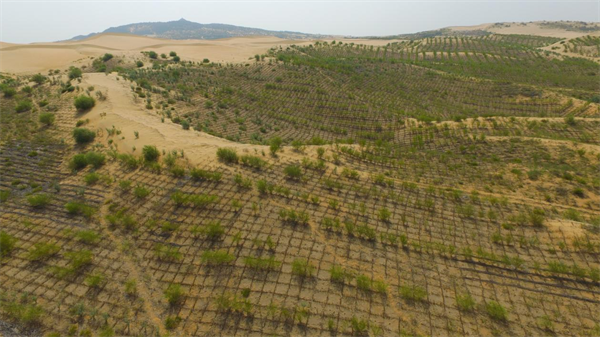
The Mu Us Sandy Land is now covered in a "plaid shirt" of sand barriers. [Photo provided to investordos.goinnermongolia.com.cn]
Sand control has been explored by people living in the desert for many years, including inserting salix into the sandy land in the form of a square lattice, planting sand-fixing plants in the middle, and carrying out comprehensive prevention and control efforts such as enclosure, tending, and replanting.
Generation after generation has worked tirelessly, with each group continuing the efforts of those before them. The land has transformed from "sands advancing, people retreating" to "greenery advancing, sands retreating", turning what was once an endless desert into a landscape shaded by green trees. What used to be lifeless has become lush and vibrant. Otog Front Banner has long been connected to the sands, and it is through these sands that it has found prosperity.
From sand willow plants to a green carpet, from little growth to a land of greenery, from the desert to the heart of revival, and from the awakening of ecological consciousness to the advancement of the Yellow River's Grand Bend battle – Dalad Banner, Ordos, located in the hinterland of the Kubuqi Desert and on the bank of the Yellow River, has also made remarkable achievements in the ecological protection of the Yellow River Basin.
In the early days of reform and opening up, Dalad Banner built a green corridor 20 kilometers long from east to west and 2 km wide from north to south on the sand line from Heilaigou to Xiliugou, blocking the Kubuqi Desert spreading to the north. In this regard, the "lock-edge forest" governance model has become a typical model of desert governance in China.
Since 2000, Dalad Banner has led a vast number of local people in unremitting afforestation efforts to prevent and control desertification, promoting the protection of natural forests, the "Three-North" shelter forests, the Beijing-Tianjin-Hebei sand source control, and other key national and local forestry projects. Dalad Banner has formed a pattern of desertification prevention and control with diversified investment from the government, collectives, and individuals by guiding all sectors of society to participate in desertification prevention and control.
At the beginning of 2024, Ordos launched the "Photovoltaic Great Wall" project, with the Dalad photovoltaic power generator's leading base in the middle. The green development model of "solar power generation on panels, sand fixation and restoration beneath, and inter-panel afforestation" drives Ordos' efforts in sand control and integrates wind and photovoltaic power.
To bring new hope to the once barren land, Ordos has insisted on continuous efforts in the comprehensive prevention and control of desertification and the construction of the "Three -North" ecological project. It has also promoted the transformation and upgrading of characteristic and advantageous industries and finally explored a powerful method for the coordinated development of new energy and ecological protection.
75-year journey to a green future
This year marks the 75th anniversary of the founding of the People's Republic of China, and in the past 75 years, Ordos has achieved remarkable results in the construction of ecological civilization through countless efforts and explorations, and "heavyweight" honors have come one after another.
In 2008, Ordos was identified by the Central Committee of the Communist Party of China as one of the 18 typical regions in 30 years of reform and opening up in China, and one of the "Seven Typical Cities for Learning and Practicing the Scientific Outlook on Development" in China. In 2009, Ordos was officially approved by the Ministry of Science and Technology as a "National Sustainable Development Experimental Zone"; in 2011, it was awarded the honorary title of "National Civilized City"; in 2013, it won the honorary title of "National Greening Model City"; in 2014, it was awarded the honorary title of "National Forest City"; and in 2014, the first batch of national ecological civilization pilot demonstration zones was approved... Kangbashi district, where the city government is located, became the first 4A-level scenic spot named after the urban landscape in China.
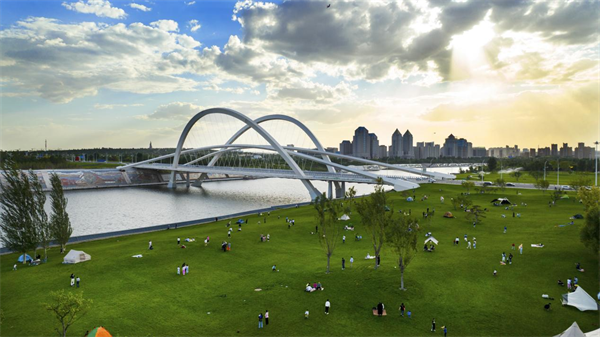
The Kangbashi district. [Photo provided to investordos.goinnermongolia.com.cn]
Over the years, Ordos has been promoting the construction of landscaping, adhered to the principle of "theme, ecology and characteristics", and organically combined the natural environment, humanities and history, and national characteristics. Intertwined and surrounded by various parks and squares, the city has witnessed a continuously-improved park and green space system.
At the same time, Ordos continues to introduce more street green spaces and community amusement parks, with a balanced distribution of parks and green spaces such as comprehensive parks, community parks, special parks, strip parks, and streetside green spaces. The urban greenways is connected in a series, and the service radius coverage rate of park greening activity venues exceeds 90 percent, truly realizing the green ecological vision of 300 meters of green, 500 meters of parks, and green through windows.
Speaking of greenery, Kangbashi cannot go unmentioned — this "grand garden" built within the city. From the very beginning of its planning and construction, Kangbashi adopted "ecological priority and green priority" as its core development philosophy, integrating the idea that "lucid waters and lush mountains are invaluable assets" into every aspect of the city's development. With high-standard planning and a unified blueprint for green development, it has become the country's first pilot city for environmental art demonstration.
Kangbashi insists on green as the background color of the development of the tourism city. Kangbashi currently has built-up area of 16.41 million square meters of green space, an urban green coverage rate of about 43 percent, and an ecological water area of 247 sq m. The urban area has 68 streetscape green streets, 17 open lawn green spaces, and 15 green parks, including a number of leisure, entertainment, and sightseeing in one of the multi-functional green spaces.
Over the past 75 years, Ordos has continuously practiced the concept of ecological priority and green development, and the "main color" of sustainable development has been polished, making it brighter and brighter. According to data, in 2023, the green space rate of the city's built-up areas was 40.8 percent, and the per capita park green space area was 32.8 sq m.
Ecological livability is not only a goal, but also an unremitting pursuit of ecological priority and green development. In this green transformation after 75 years, in this vibrant and energetic land, Ordos has taken ecological livability as its goal, guarded this green, this blue, and this pure, and drawn a new blueprint for the harmonious living environment between man and nature. In the future, let us witness the green transformation of the city and feel its firm pace and infinite possibilities on the road of ecological livability!